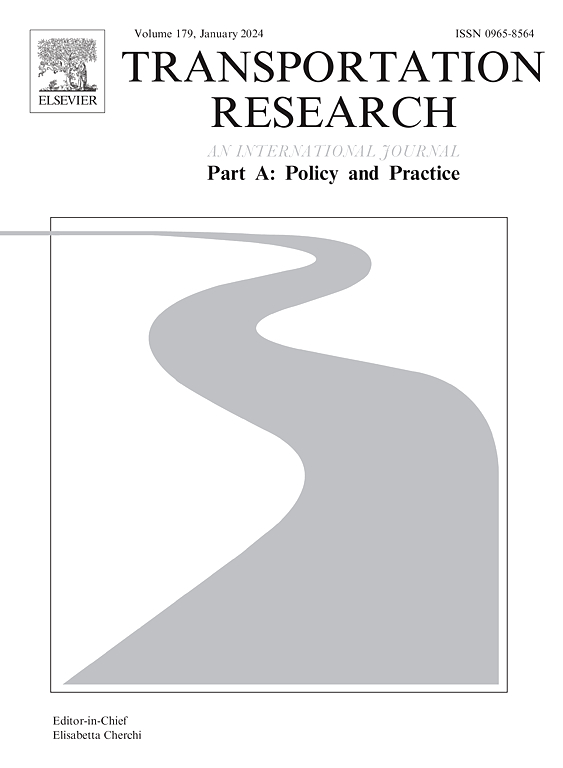居民的自我选择以及出行因素在选择减少汽车出行的居民区时的相对重要性
IF 6.8
1区 工程技术
Q1 ECONOMICS
Transportation Research Part A-Policy and Practice
Pub Date : 2024-09-24
DOI:10.1016/j.tra.2024.104266
引用次数: 0
摘要
减少汽车居住区是一种城市规划工具,通过降低居民拥有和使用汽车的吸引力,限制因城市发展而增加的机动车流量。由于减少用车的生活方式对某些人比对其他人更有吸引力,因此减少用车的街区可能会受到住宅自我选择(RSS)的影响。自我选择效应表明,个人选择的居住区支持原有的出行态度和偏好,因此,他们的出行行为并不完全是建筑环境的结果。相比之下,我们认为居住地点选择中的出行考虑因素(TCRC)在这方面更为精确。态度指的是对某种出行方式的心理状态,例如个人对骑自行车的喜爱,而出行考虑因素则描述了人们对居住地的实际向往,例如该地区的街道布局有利于骑自行车。我们发现,与房屋面积和价格等因素相比,交通控制中心的影响较小。然而,通过对低汽车取向者和高汽车取向者的比较发现,前者在选择社区时更优先考虑减少汽车的设计。其次,我们发现新居民在搬迁后对汽车的使用减少了,而对汽车共享的使用增加了。第三,在行为改变模型中测量 RSS 时,我们发现态度和 TCRC 之间没有明显差异。就政策影响而言,进一步发展减少汽车的社区将(i)促使新居民更多地使用可持续交通方式,(ii)使已经很少开车的人更容易保持对汽车的独立性。本文章由计算机程序翻译,如有差异,请以英文原文为准。
Residential self-selection and the relative importance of travel considerations in the residential choice of a car-reduced neighbourhood
Car-reduced neighbourhoods are an urban planning tool to limit the increase in motorised traffic due to urban growth by making car ownership and use less attractive for the inhabitants. Since car-reduced living appeals more to some people than others, car-reduced neighbourhoods may be subject to residential self-selection (RSS). RSS indicates that individuals choose residential areas that support pre-existing travel attitudes and preferences, and, in consequence, that their travel behaviour is not solely the result of the built environment.
Many studies on RSS operationalise self-selection effects using travel-related attitudes. In contrast, we assume that travel considerations in residential location choice (TCRC) are more precise for this purpose. While attitude refers to a mental state towards a travel mode, e.g. a personal affection for cycling, TCRC describes an actual desire to live in an area with, for example, street layouts that facilitate cycling.
Drawing on a sample of 339 recently relocated inhabitants of a car-reduced neighbourhood in Darmstadt, Germany, we first identify the importance of TCRC in choosing this neighbourhood relative to other residential considerations. We find that TCRC have less influence compared to factors such as house size and price. However, a comparison of individuals with low and high car orientation reveals that the former prioritise car-reduced designs more when selecting a neighbourhood. Second, we find that new residents’ car use decreases after relocating, while carsharing use increases. Third, we find no significant difference between attitudes and TCRC when measuring RSS in our behaviour change models. In terms of policy implications, the further development of car-reduced neighbourhoods will (i) trigger an increase in the use of sustainable modes among new residents and (ii) make it easier for people who already rarely drive to maintain their car independence.
求助全文
通过发布文献求助,成功后即可免费获取论文全文。
去求助
来源期刊
CiteScore
13.20
自引率
7.80%
发文量
257
审稿时长
9.8 months
期刊介绍:
Transportation Research: Part A contains papers of general interest in all passenger and freight transportation modes: policy analysis, formulation and evaluation; planning; interaction with the political, socioeconomic and physical environment; design, management and evaluation of transportation systems. Topics are approached from any discipline or perspective: economics, engineering, sociology, psychology, etc. Case studies, survey and expository papers are included, as are articles which contribute to unification of the field, or to an understanding of the comparative aspects of different systems. Papers which assess the scope for technological innovation within a social or political framework are also published. The journal is international, and places equal emphasis on the problems of industrialized and non-industrialized regions.
Part A''s aims and scope are complementary to Transportation Research Part B: Methodological, Part C: Emerging Technologies and Part D: Transport and Environment. Part E: Logistics and Transportation Review. Part F: Traffic Psychology and Behaviour. The complete set forms the most cohesive and comprehensive reference of current research in transportation science.

 求助内容:
求助内容: 应助结果提醒方式:
应助结果提醒方式:


